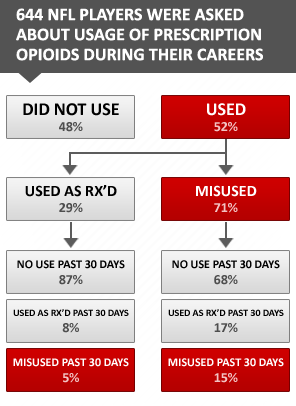CloakNNNdagger
Hall of Fame
The data on NFL painkiller use and misuse
From March to August 2010, Cottler's research team interviewed 644 former NFL players by telephone. The players who participated in the research retired from the NFL between 1979 and 2006, played an average of 7.6 seasons, and averaged 48 years in age. Researchers asked them a series of questions about their health, pain levels, NFL-related injuries and their use and misuse of prescription painkillers and other substances.
Robert Boston, Washington University School of Medicine
Linda Cottler, Washington University in St. Louis researcher.
When asked about their prescription painkiller use within the past 30 days, 7 percent of the retired players surveyed said they either used more prescription pain medication than prescribed by their doctors, used the medication without a prescription at all, or both.
"That's a very large number in a population that, at that age, we wouldn't expect to see much use of these substances at all," Compton said. "Most typical 30- and 40-year olds aren't taking pain relievers, and they're not misusing them, so that's a much higher than expected rate."
The rate of current misuse of prescription pain medications within the general population age 26 and older is 1.6 percent, according to data from the National Survey on Drug Use and Health, an assessment conducted by the Substance Abuse and Mental Health Services Administration (SAMHSA), a division of the federal Department of Health and Human Services. The rate of misuse within the past 30 days for men older than 26 is 2.5 percent, according to the latest SAMHSA drug survey.
"[The former players] are three times as likely as men their age in the general population to be misusing prescription opioids right now. I think that's a lot," Cottler said.
The NFL's Brown said that drug-use statistics for the general population tend be artificially low because surveys typically do not include high-risk populations like prisoners or the homeless.
The Washington University study also focused on the retired players' past prescription drug use, including the period of their NFL careers.
What is an opioid?
Opioids are synthetic versions of opium. They have the ability to reduce pain but can also suppress breathing to a fatal degree when taken in excess. Examples of opioids are oxycodone (OxyContin®), hydrocodone (Vicodin®) and methadone. There has been at least a 10-fold increase in the medical use of opioid painkillers during the past 20 years because of a movement toward more aggressive management of pain. Because opioids cause euphoria, they have been associated increasingly with misuse and abuse.
Source: "Unintentional Drug Poisoning in the United States," a report by the Centers for Disease Control and Prevention
When asked about their prescription painkiller use while playing in the NFL, 52 percent of the retired players said they used prescription pain medication then, while 48 percent said they never used the drugs while playing. Of the players who said they used prescription painkillers while in the NFL, 71 percent admitted misusing the drugs, and 15 percent admitted to misusing prescription pain medications within the past 30 days.
Researchers found retired players who misused prescription painkillers while playing in the NFL were three times more likely to misuse the drugs today than those who used the pills as prescribed while playing.
"That's pretty amazing that misuse now is determined by whether [the former players] misused while in the NFL," Cottler said.
"People will often continue to use drugs for reasons that are different than the reasons that they started using them," said Strain. "My concern would be that these players start using these drugs for pain-relieving purposes but then could find that they're unable to function without the use of these drugs."

The rest of the story
It is an unfortunate sequence that follows many NFL players for life. It is not uncommon that players are well-supplied with narcotics "legally" by the team to make some of them "functional." However, once they leave football, their "legal" supplier disappears and physicians outside of the game are reluctant to prescribe in the doses and amounts previously prescribed........so illegal narcotics are supplied to either "supplement" their private physician's prescription or substitute it if they cannot find a physician that feels the narcotic is indicated. Of course, having multiple physicians (one not knowing of the other) see them for the same problem many times can allow them to obtain what they feel is an adequate dose and supply.
